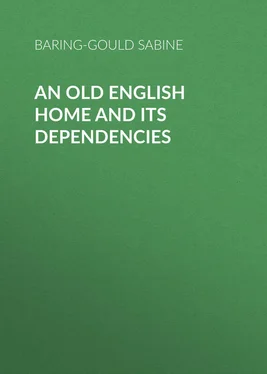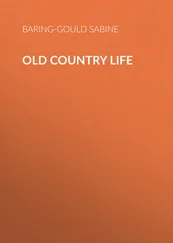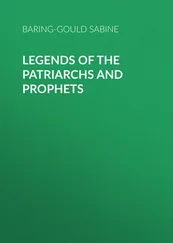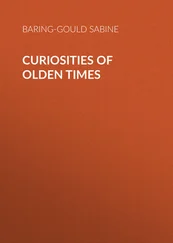Sabine Baring-Gould - An Old English Home and Its Dependencies
Здесь есть возможность читать онлайн «Sabine Baring-Gould - An Old English Home and Its Dependencies» — ознакомительный отрывок электронной книги совершенно бесплатно, а после прочтения отрывка купить полную версию. В некоторых случаях можно слушать аудио, скачать через торрент в формате fb2 и присутствует краткое содержание. Жанр: foreign_antique, foreign_prose, на английском языке. Описание произведения, (предисловие) а так же отзывы посетителей доступны на портале библиотеки ЛибКат.
- Название:An Old English Home and Its Dependencies
- Автор:
- Жанр:
- Год:неизвестен
- ISBN:нет данных
- Рейтинг книги:5 / 5. Голосов: 1
-
Избранное:Добавить в избранное
- Отзывы:
-
Ваша оценка:
- 100
- 1
- 2
- 3
- 4
- 5
An Old English Home and Its Dependencies: краткое содержание, описание и аннотация
Предлагаем к чтению аннотацию, описание, краткое содержание или предисловие (зависит от того, что написал сам автор книги «An Old English Home and Its Dependencies»). Если вы не нашли необходимую информацию о книге — напишите в комментариях, мы постараемся отыскать её.
An Old English Home and Its Dependencies — читать онлайн ознакомительный отрывок
Ниже представлен текст книги, разбитый по страницам. Система сохранения места последней прочитанной страницы, позволяет с удобством читать онлайн бесплатно книгу «An Old English Home and Its Dependencies», без необходимости каждый раз заново искать на чём Вы остановились. Поставьте закладку, и сможете в любой момент перейти на страницу, на которой закончили чтение.
Интервал:
Закладка:
On a winter evening, the farmer and his wife and the serving maidens and young men come into the kitchen, and the circle is completed with chairs or stools, the curtains are drawn, the fire is made up, and a very jolly evening is spent with cakes and cider, and tales and jokes and song.
I was at a sale one day – a very small farm but an old one. A farmer bid for the settle – a small one. One of his daughters was there. She turned to her sister and said: "I say, Nan, vaither he've gone and bought the settle, and it's lovely; it will hold only two."
"Well, Jane," said her sister, "I reckon – that depends. You must have the right one beside y'; then it's just large enough, and you don't want no more."
When I was a child, some sixty years ago, the mat before the fire was the line of demarcation, beyond which a youngster might not go.
"My dear," said my grandmother, "fires are made to be seen – not felt."
Oh, how we shivered beyond the mat! I used to look at a patent bacon-toaster, and resolve, when I was a man and independent, to have a curved settle formed of burnished tin, and to sit before a roaring fire in the focus of all the converging rays, and never stir therefrom from Michaelmas till Lady Day. But the curved settle answers the purpose.
Among the troubles and irritations of life, one of the worst is a smoky chimney, and among all the hideousness of modern contrivances nothing surpasses the cowl.
It is very curious that architects should set themselves to work to violate first principles, and so involve us in these troubles. In the first place, to ensure that a chimney shall not smoke, the flue must be made large enough to carry the smoke. This is a principle very generally neglected. Next it is necessary that the chimney should not have a flat top, for then the wind beats against the broad surface, and, of course, prevents the smoke from rising, and much of it is deflected down the flue.
What our forefathers did was to reduce the top to a thin edge that could not arrest and drive the smoke down, but would, on the contrary, assist it in rising. Or else they covered over the orifice with a roof, open at the sides, that prevented the wind from descending, and enabled the smoke to get away whichever way the wind blew.
In order to illustrate what I mean, I have simply taken my pencil and gone outside my house, and have drawn an old and a new chimney-top.
The chimney-piece or overmantel is the reredos of the family altar, and should contain the arms of the family or the portraits of ancestors.
No portion of an old manor-house was so decorated and enriched as this; and the hall fireplace received pre-eminent attention.
Happily we have in England numerous and splendid examples; but a vast number were sacrificed at the end of last century and the beginning of the present, when large looking-glasses came into fashion, and to make place for them the glorious old sculptured wood was ruthlessly torn down. If the reader is happy enough to possess a copy of Dr. Syntax's Tours , he will see the period of transition. In the second Tour is a plate representing the doctor visiting the Widow Hopefull at York. The room is panelled with oak, the ceiling is of plaster beautifully moulded, the chimney-piece is of oak carved, but painted over, and the large open hearth has been closed in, reduced, and a little grate inserted.
In the same volume is a picture of Dr. Syntax making his will. Here the large open fireplace remains, lined with Dutch tiles, and the fire is on dogs. All the lower portion of the mantel decoration remains, but above the shelf everything has been removed to make way for the mirror.
In the same volume is Dr. Syntax painting a portrait, and here again is a lovely panelled room with plaster ceiling and a simple but charming chimney-piece of excellent design.
Now turn to the first Tour, and look at Dr. Syntax mistaking a gentleman's house for an inn. Here we have the chimney-piece supported on vulgar corbels, all of the period when Rowlandson drew; above the shelf is a painting in the worst description of frame. When Rowlandson made his drawings, he was absolutely incapable of appreciating Gothic design, and whenever he attempted this he failed egregiously, but the feeling for what was later, Elizabethan and Jacobean, was by no means dead in him, and he drew the details with a zest that shows he loved the style.
CHAPTER IV.
Old Furniture
To my taste old furniture in a modern jerry-built villa residence is as out of place as modern gim-crack chairs and tables and cabinets in an ancient mansion. In the first instance you have solidly constructed furniture in a case that is thin, and not calculated to last a century. With regard to the second, happily we have now excellently designed furniture, well constructed on old models; and what I mean by gim-crack stuff is that which was turned out by upholsterers to within the last fifteen years.
Look at the construction of a chair, and see what I mean.
Full well do I recall the introduction into my father's house of these chairs. Only a fragment of one now remains. Observe the legs; they curve out below, and are as uncalculated to resist the pressure downward of a heavy person sitting on them, as could well be contrived. Then again the braces – look at them; they are spindles with the ends let into holes drilled half-way through the legs. Old braces were braces, these are mere sources of weakness, they do not brace; when weight is applied to the seat the tendency is to drive the legs apart, then out falls the brace. No mortice holds it, it has no function to fulfil. In the old chair how firm all the joints are made! Stout oak pegs are driven through every mortice, and every precaution is taken to prevent gaping at the joints, to resist strain put on them.
Mention has been made of the great looking-glass, which was the occasion of the destruction of so many carved chimney-pieces. There was another introduction, and that into the drawing-room, which produced a disfiguring effect, and that was the large circular rosewood table.
At the beginning of this century it entered our parlour, settled there, and made the room look uncomfortable. By no arrangement of the furniture could the drawing-room be given a cosy look. The table got in the way of visitors, it prevented the formation of pleasant groups; it was a very barrier to friendship, and a block to conversation.
One evening, in the South of France, I received intimation from a M. Dols, avocat, that he would be pleased to receive me. I had sent word to him before that I should like to call on him and see some interesting flint swords and celts in his possession. He asked me to call in the evening at 8 p.m. Accordingly I went to his door, and was ushered into the salon . The centre was occupied by a table, of considerable size, and the family was seated beyond the table.
M. Dols occupied B; Mme. Dols occupied C; M. Dols' mother was planted at D; and the maiden sister of Mme. Dols at E. M. Gaston Dols, the son, was at G, and Mlle. Eulalie Dols, the daughter, at F. The chair A was left vacant for the visitor.
But conceive the situation! To be introduced like a criminal before six judges, then, when one had reached the seat allotted, to be planted one in a row, and to have to distribute remarks right and left; to address the ancestress at D across the shirtfront of M. Dols at B, and to say something pretty to the old maid at E athwart the swelling bosom of Mme. Dols at B!
If only that detestable table could have been got rid of, we would have gravitated together into a knot and been happy – but to be lively and chatty in espalier was impossible.
Well! it was almost as bad in the old days, when we had large round tables in our drawing-rooms; and one of the great achievements of modern – I mean quite recent – times has been the bundling of that old rosewood table out. That gone, the rest of the furniture gets together into comfortable groups, and everything finds its place. Before, all were overawed and sent to the wall in deference to the round table.
Читать дальшеИнтервал:
Закладка:
Похожие книги на «An Old English Home and Its Dependencies»
Представляем Вашему вниманию похожие книги на «An Old English Home and Its Dependencies» списком для выбора. Мы отобрали схожую по названию и смыслу литературу в надежде предоставить читателям больше вариантов отыскать новые, интересные, ещё непрочитанные произведения.
Обсуждение, отзывы о книге «An Old English Home and Its Dependencies» и просто собственные мнения читателей. Оставьте ваши комментарии, напишите, что Вы думаете о произведении, его смысле или главных героях. Укажите что конкретно понравилось, а что нет, и почему Вы так считаете.












